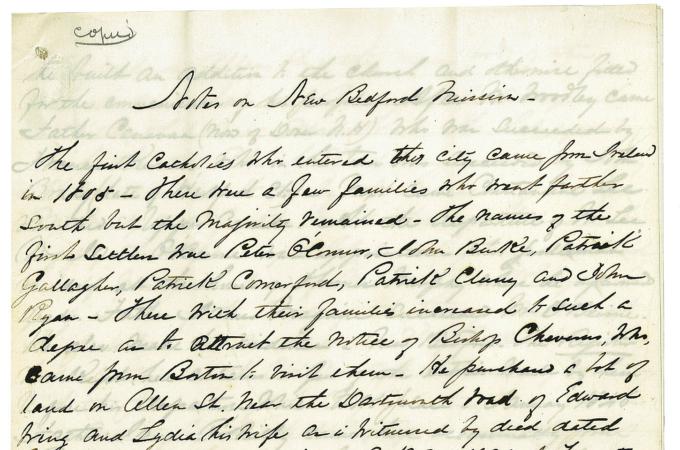Mission at New Bedford
Last summer, this column highlighted a document by Father Henry E.S. Henniss describing the history of Catholic missions on Nantucket. While responsible for Nantucket, Father Henniss had also served much of the local area, including New Bedford, and also composed a document entitled "Notes on New Bedford Mission," dated July 21, 1857.
In this document, Father Henniss reveals that the first Catholics in New Bedford were several families of immigrants who recently arrived from Ireland, in 1805, three years before the Diocese of Boston was created. The original settlers -- Peter O'Connor, John Burke, Patrick Gallagher, Patrick Connorford, Patrick Cleary, John Ryan -- and their families saw a substantial community grow around them in the following years.
It was not long before Bishop Jean Cheverus took notice of this burgeoning Catholic community and went to see it for himself. He must have been impressed with what he saw, as he purchased land at the intersection of Allen and Dartmouth Street on March 3, 1821.
The following year, Father Philip Lariscy, OSA, arrived and began raising funds to build a church on the lot purchased by Bishop Cheverus. His venture proved successful, and a 30 by 45 foot church was constructed by Dudley Davenport for the price of $800; Bishop Cheverus would return to dedicate the completed building. Father Lariscy's successor, Father Robert D. Woodley would expand upon this original structure, raising $118.50 from local Protestant merchants to build an addition.
There was a succession of about seven priests between Father Woodley and Father Thomas R. McNulty, the latter of whom served the mission for nearly eight years, during which, Father Henniss writes, "the Catholics became more numerous and the Old Church incapable of accommodating them."
To address this issue, Father McNulty raised money and purchased a church from the Universalist Congregation at the corner of Fifth and School Streets for $3,500, and named it after St. Mary. The original church was sold for $100 and, interestingly, the new owner disassembled it and moved it across the street. The original lot it stood on, purchased by Bishop Cheverus, became a cemetery for a short time.
In 1854, Father McNulty's successor closed the cemetery, prohibiting further burials, and sold the unused land. With permission of the town, bodies were removed to a new cemetery in 1856, at which time the remaining land was sold. All profits from the land were used to repay the debt owed on the Universalist Church, and it was then deeded to the Bishop of Boston. That same year, an addition to the church doubled its size, a sign that the Catholic population continued to grow through the mid-19th Century.
- Thomas Lester is the archivist of the Archdiocese of Boston.



















